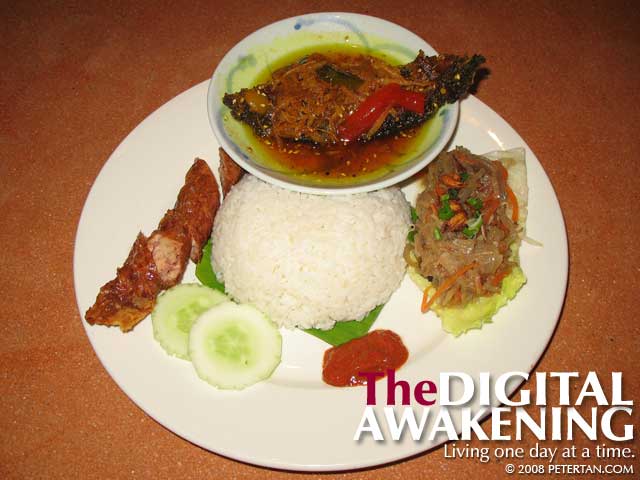
Little Penang Kafe Acar Fish Set – (from top clockwise) Acar fish, jiu hoo char, sambal belacan, sliced cucumber, lor bak and white rice.
Whenever I have a pining for home-cooked food Penang style, there are only a few eateries in the Klang Valley that can satiate my appetite. Little Penang Kafé, which has several outlets here, is the one Wuan and I usually head to. The outlet we frequent often is at Mid Valley Megamall as we hang out there a lot on weekends. Each time we ate there, I resolved to try something different but invariably settled for the Acar Fish Set consisting of white rice, acar fish, jiu hoo char and lor bak. The other two outlets we pop in whenever we are in the vicinity are at Suria KLCC and The Curve.
Acar fish is fish slices that are deep-fried and then pickled in rice vinegar, turmeric, julienned ginger, sliced garlic and red chilli. Jiu hoo char is dried cuttle fish yam bean (sengkuang) and carrots that are julienned and stir fried together with belly pork, sliced shiitake mushrooms, onions and chopped garlic. Lor bak is chopped belly pork marinated with five spice powder, soya sauce, sugar, salt, pepper and shallots and made into rolls with bean curd sheets.
Little Penang Kafe serves halal food. The belly pork in jiu hoo char and lor bak are replaced with chicken. Both dishes without belly pork just do not feel as authentic as they should be in the mouth. The lor bak still maintains the aroma and flavour and is delicious nonetheless. The jiu hoo char has prawns added and is garnished with spring onions and deep fried shallots. The jiu hoo char that I like neither comes with prawns nor have garnishing. Perhaps it was added more for presentation purposes than anything else. I would have loved it more had it been stir fried longer to bring out its flavour. I usually eat the jiu hoo char with sambal belacan.
I grew up eating a hodgepodge of Peranakan (Nyonya) cuisine. These are usually served on weekends when the family got together for more scrumptious meals. It included nasi lemak, laksa, popiah, lam mee, lor bak, jiu hoo char, otak-otak and perut ikan, among others. Different cooks would use different amount of ingredients or even use slightly different ingredients that may make the taste varied and unique. The tastes that I like are more mainstreamed. That is what one would get from hawkers and eateries proffering such cuisines.



